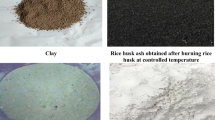Abstract
There are vast zones of clay soils which are generally extracted up to 3m deep (active layer). Owing to humidity variations throughout the year, this type of soil causes much damage to structures due to continuous changes in volume. Very often the clay is discarded and substituted by inert materials at the construction stage. The use of hydrated lime with this type of soil is a treatment that aims to inhibit the already volumetric instability by using the resulting mixture as inert material (Nelson, J.D., Miller, D.J.: Expansive Soils, Problems and Practice in Foundation and Pavement Engineering. John Wiley & Sons, Inc., USA, (1992)). Additionally, it is known that such a mixture also improves the strength properties, and it is possible to use it as a resistant inert composite, at low cost, for construction material. Nevertheless, due to the lack of tracking of this composite over time, safety issues related to the durability of such properties are uncertain. Because of the above, in this work, the composite was subjected to a constant exposure to temperature to simulate the evolution process of the composition on a laboratory scale, assuming that the acquired properties originate from the mineralogical composition created at the time of the sample. The permanence of such composition is associated to the properties acquired since the beginning.
Similar content being viewed by others
References
Castaño, M.V., López-Lara, T., López, C.C.: Comparative study of the effectiveness of different additives on the expansion behavior of clays. Electronic Journal of Geotechnical Engineering, USA, 4 (1999)
Fernández Loaiza, C.: Mejoramiento y Estabilización de Suelos- Ed. Limusa, México (1982)
López-Lara, T: Reflexión y análisis sobre el tratamiento de suelos con diferentes materiales. Curso: Técnicas modernas de caracterización en la Ciencia y la Tecnología de suelos arcillosos. UAQ, Querétaro, Qro, México (1998)
López-Lara, T.: Estudio Fisicoquímico de la modificación de suelos arcillosos. Tesis de doctorado, Fac. de Ingeniería, UAQ, Querétaro, Qro, México (2002)
López-Lara, T.: Mineralogical Characterization of Stabilized soils. The Electronic Journal of Geotechnical Engineering, EJGE, USA, 9 (2004)
Manfred, R.H.: Enginnering Principles of Ground Modification. Mc Graw Hill Publishing Company, USA (1990)
Manuales anuales editados por el Joint Committee on Power Diffraction Standards del International Center for Diffraction Data. Pennsylvania, USA (1950–1988)
Nelson, J.D., Miller, D.J.: Expansive Soils, Problems and Practice in Foundation and Pavement Engineering. John Wiley & Sons, Inc., USA (1992)
Puente Tamayo, E.M.: Estudio de la estabilización de suelos arcillosos utilizando cal. Tesis de Licenciatura. Facultad de Ingeniería, UNAM, México (1986)
Trejo Moedano Ángel, Patología de las cimentaciones sobre suelos expansivos. X. Congreso panamericano de mecánica de suelos e ingeniería de cimentaciones. México (1995)
Zepeda, G., J.A. y Castañeda, A.H.: Cimentaciones con pilotes y pilas. Cimentaciones sobre arcillas expansivas. México (1986)
Zepeda Garrido, J.A., Castañeda, A., Hugo: Distribución de suelos expansivos en la República Mexicana. Curso Internacional de Mecánica de Suelos Arcillosos UAQ, Querétaro, México (1992)
Author information
Authors and Affiliations
Corresponding author
Rights and permissions
About this article
Cite this article
López-Lara, T., Horta-Rangel, J., Hernández-Zaragoza, J.B. et al. Properties of waste soil—hydrated lime composite. Mech Time-Depend Mater 10, 155–163 (2006). https://doi.org/10.1007/s11043-006-9014-1
Accepted:
Published:
Issue Date:
DOI: https://doi.org/10.1007/s11043-006-9014-1




